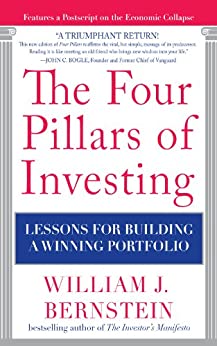Book Review: The Four Pillars Of Investing
My summer reading book was The Four Pillars of Investing: Lessons For Building a Winning Portfolio by William Bernstein, which traditionally makes the top ten lists of best personal investing books, but which I had never read until this year.
Bernstein, a trained neurologist-turned-investment-writer-and-advisor, originally published The Four Pillars in 2002 and then updated it in 2010.
Although I had never read Bernstein’s Four Pillars before this week, I can honestly say that I have, over the years, 100 percent absorbed his philosophical approach to personal investing. There is almost no daylight between what he thinks we should do and what I think we should do. I guess that means I have read many of the other books or papers that underpin his approach. Or that I’ve been reading people influenced by Bernstein. Or maybe just that there is a single objectively best way to go about personal investing and we have independently arrived at the same place. (Honestly I’m sure it’s the first two options, not the third). So, if you were a blank slate and wondering what philosophical approach you should bring to investing – and you really trusted my judgment – then I would posit that you could read Bernstein and therefore know just what I would endorse.
The four pillars of Bernstein’s title are the theory, history, psychology, and business of investing. Bernstein offers a lightning round – a mere 200 pages – describing what you need to know about these four topics. In his fifth and final section he brings together a practical “how to” based on the earlier chapters. Spoiler alert: The “how to” is diversified index funds.
The prose is relatively easy – except maybe parts of the early chapters on investing theory – in which a bit of math could bog down casual readers.
On investing theory, Bernstein says you must expose yourself to risk in order to receive a positive return, markets are more efficient than you think, and that fundamental investing derives from valuing future cashflows with a mathematical calculation that tells you what those cash flows are worth today. All very solid stuff.
Knowing investment history is the key next step. I learned plenty about the development of mutual funds and the origin-stories of firms like Merrill Lynch, Fidelity, and Vanguard, plus deeper histories – always useful – about up-market manias and down-market busts. His history of Vanguard and its role in pioneering low-cost mutual funds is worth the price of admission.
I believe that understanding investing psychology – the problems coming from inside our own brain – is the key to succeeding as an individual investor. Berstein explains the pitfalls of misunderstanding risk, the classic errors of confusing luck and skill, being overinfluenced by the recent past, and finding patterns where there are none.
Finally, understanding the business of investing – the real way in which investment firms earn a living from us – is essential.
There are investment companies and there are marketing companies disguised as investment companies. Bernstein posits that ninety percent are really marketing companies while only 10 percent are investment companies. The majority of investment professionals are focused on sales, not investing. One way you can spot the marketing companies is because they sell high-fee mutual funds, load funds, variable annuities, and other insurance products.
Is The Four Pillars perfect? No.
Many of his stories read like they came from the early 2000s, in the sense of salient anecdotes from the financial world and references to events in the 80s and 90s that only older folks will remember vividly.
One area I disagree with Bernstein is on workplace retirement accounts like 401(k) plans, which he warns are disasters. In contrast I think they are quite beautiful and important.
He writes,
“The ascent of self-directed, defined-contribution plans – of which the 401(k) is the most common type – is a national catastrophe waiting to happen. The average employee, who is not familiar with the market basics outlined in this book, is no more able to competently direct his own investments than he is to remove his child’s appendix or build his own car.”
I worry that people reading his view that they are a disaster would then not take advantage of their tax-deferred workplace investment programs.
But I take his point that few people are prepared to maximize their opportunity or to efficiently manage their own investing. Reading one or two classic personal investing books – like his – would go a long way toward correcting this problem.1
Bernstein’s section on investment fees seems outdated to me, in that he’s referencing 2 percent investment advisor fees and the prevalence of front-loaded mutual funds. Don’t get me wrong, these still exist and Bernstein’s main point still stands, which is that traditionally the money management industry charges ridiculously high fees and delivers mediocre results. The trends have improved over the past 20 years and fees, thankfully, have been coming down in some – but not all! – areas of investing.
You could accurately call The Four Pillars a slightly dated book. In an important sense, however, a bit of mustiness enhances the credibility of a personal finance book, to me. It means the book has stood the test of time. It means something timeless and true is being taught, rather than timely but ephemeral.

My own personal Mount Rushmore of investing books were first published in 1999, 1978, 1973, and 1949. They are Simple Wealth, Inevitable Wealth by Nick Murray; The Only Investment Guide You’ll Ever Need by Andrew Tobias; A Random Walk Down Wall Street by Burton Malkiel; and The Intelligent Investor by Benjamin Graham, respectively.
You will gain more from reading one of those books than you possibly could learn in hundreds of hours watching videos, browsing online, or even – gasp! – reading this blog. Bernstein in The Four Pillars makes the correct observation that investment journalism has an inherent problem in that the correct thing to advocate – always and only invest in terribly boring index funds – is the dullest possible story. How can we write headlines with that message day after day? So instead we write endlessly about the improbable and the sensational – the cryptocurrencies and the billionaires. It’s much more interesting to write headlines about Dogecoin and GameStop, despite the fact that these are, or should be, deeply irrelevant to our lives.
I enjoy learning about other finance books I have yet to read, so please feel free to send me your top recommendation – something that improved your relationship with money and investing. Thanks!

ps. My secret ambition is that someday every else’s personal Mount Rushmore of Personal Finance books will include my book, The Financial Rules For New College Graduates.
I have one other mild critique: I don’t love the way Bernstein explains the math of discounting cashflows. That happens to be an obsession of mine, so I may be overly critical, but nevertheless I didn’t think his math explanations were as clear as they could have been.
Thanks for visiting Bankers Anonymous. Be sure to sign-up for Michael's newsletter so you ...
more



